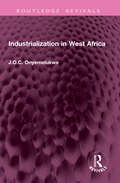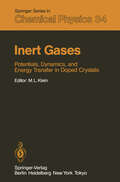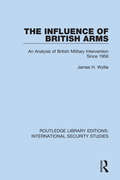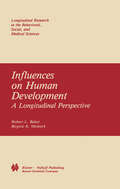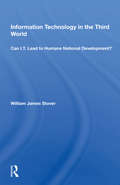- Table View
- List View
Industrialization in West Africa (Routledge Revivals)
by J O OnyemelukweFirst published in 1984, Industrialization in West Africa is an authoritative text on the industrial development efforts, spatial characteristics and related problems of countries comprising the West African region. The book commences with a detailed description of the political and economic background against which the slow and unsteady pace of industrialization in each country can be appreciated. The analysis outlines the resource potential and historical evolution and structural characteristics of modern manufacturing in the region. The final section assesses the spatial characteristics of West African industrialization, the major problems inhibiting industrial development and frustrating efforts towards economic independence by each country. In conclusion the author considers remedial policy options open to West African countries, both individually and in a common market framework. This book is a valuable source material for all students of social science, geography, economics and regional planning.
Industrialization in West Africa (Routledge Revivals)
by J O OnyemelukweFirst published in 1984, Industrialization in West Africa is an authoritative text on the industrial development efforts, spatial characteristics and related problems of countries comprising the West African region. The book commences with a detailed description of the political and economic background against which the slow and unsteady pace of industrialization in each country can be appreciated. The analysis outlines the resource potential and historical evolution and structural characteristics of modern manufacturing in the region. The final section assesses the spatial characteristics of West African industrialization, the major problems inhibiting industrial development and frustrating efforts towards economic independence by each country. In conclusion the author considers remedial policy options open to West African countries, both individually and in a common market framework. This book is a valuable source material for all students of social science, geography, economics and regional planning.
Inert Gases: Potentials, Dynamics, and Energy Transfer in Doped Crystals (Springer Series in Chemical Physics #34)
by R. A. Aziz S. S. Cohen H. Dubost M. L. KleinResearch involving the chemical physics of the inert or rare gases continues unabated. This small volume is meant to deal with advances that have occurred in three selected areas over the past decade. It forms a natural outgrowth of earlier reviews and volumes that have dealt almost exclusively with pure rare-gas solids. Originally, a single chapter was envisaged to cover the topic of alloys and impurities in solid rare gases. However, over the past ten years this single chapter spawned many offshoots and eventually the project became too large for a single volume. Thus the present book contains only a small subset of possbile topics involving rare-gas solids intentionally doped with impurities. Chapter 1 gives a brief overview of current research devoted to the rare gases. This is followed by a comprehensive, self-contained chapter dealing with the most recent developments in the area of interatomic inter actions. Chapter 3 is concerned with the lattice dynamics of rare-gas solids doped with an impurity which is either another rare-gas or a small molecule. The final chapter deals with the spectroscopy of vibrating and rotating di atomic impurities in rare-gas solids. The birth of this volume was not without its labour pains. I should like to take this opportunity to thank the various people who have at one time or another been involved throughout its gestation period. Clearly, many important topics are omitted from this volume.
Infant Memory: Its Relation to Normal and Pathological Memory in Humans and Other Animals (Advances in the Study of Communication and Affect #9)
by MorrisMoscovitchThe study of infant memory has flourished in the past decade for a number of reasons, not the least of which is the tremendous growth of interest in normal and pathological adult memory that began in the late fifties. Despite its common lineage to other areas of memory research, however, infant memory has perhaps been the least integrated into the mainstream. In reading the literature, one gets a sense of discontinuity between the study of infant memory and memory at all other stages of development from childhood to old age. The reasons for this are not hard to find. The techniques used to study memory in infants are usually very different from those typically used even in children. These techniques often limit the kind of inferences one can draw about the nature of the memory systems under investigation. Even when terms, concepts, and theories from the adult literature are applied to infants, they often bear only a loose relationship to their original usage. For example, an infant who stares longer at a new pattern than an old one is said to "recognize" the old one and to have a memory system that shares many characteristics with a memory system that makes recognition possible in adults. Simi larly, an infant who emits a previously learned response, such as a leg kick, to an old stimulus is said to "recall" that response and to be engaged in processes similar to those of adults who are recalling past events.
Infectious Diseases of the Central Nervous System (Neurologic Illness)
by John R. Green Richard A. ThompsonThe contents of this volume are based upon the proceedings of a Sympo sium entitled "Infectious Diseases of the Central Nervous System" held in Phoenix, Arizona, and sponsored by the Barrow Neurological Institute and Foundation during its Ninth Annual Symposium. The purpose of the Symposium was to bring together knowledgeable experts in this field to review information that is available and to enhance our knowledge of new developments in the field of infectious diseases in the central nervous system. Because the subject could not be covered in its entirety by this volume, we have placed particular emphasis on recent developments and new information. The volume includes a remarkably fresh and interesting discussion of viral diseases as they affect the nervous system, including conventional and unconventional virus agents, and in addition, discussions of path ophysiology and epidemiology and postinfectious diseases of the nervous system. A similar approach is taken to the treatment of bacterial infection. Discussions of pathophysiology are intertwined with discussions of diag nostic techniques, prevention techniques and treatment of bacterial in fections. Additional surgical problems are discussed regarding prevention and management of peri operative infection and brain abscess. Special consid eration was given to coccidioidomycosis which is prevalent in the western states; also, there is a discussion of parasitic infections. This volume will be of interest to neurologists and neurosurgeons and any physician dealing with infectious disease. RICHARD A. THOMPSON, M.D. JOHN R. GREEN, M.D.
Infertility: Diagnosis and Management (Clinical Perspectives in Obstetrics and Gynecology)
by James AimanThe authors of this book have a goal-to describe the management of infertility from the perspective of physiology and anatomy gone awry. To accomplish this goal, the chapters devoted to the causes of infertil ity begin with a description of the normal structure and function of the organ or system causing the infertility. We believe that under standing the normal will result in rational and effective diagnosis and treatment of infertility. Our intent is that this book be a useful re source for those who care for infertile couples. For an infertile couple, success is the delivery of a normal and healthy infant. Chapters that describe the causes and treatment of habitual abortion and the reproductive performance of previously infertile couples emphasize the hazards that exist between conception and birth. Our environment is one of these hazards, one that may also affect reproduction before conception. A chapter is devoted to a de scription of environmental agents that affect reproduction, the mech anisms of their effect, and methods to predict those present and future environmental agents which might also affect reproduction.
Infinite-Dimensional Systems: Proceedings of the Conference on Operator Semigroups and Applications held in Retzhof (Styria), Austria, June 5-11, 1983 (Lecture Notes in Mathematics #1076)
by F. Kappel W. SchappacherThe Influence of British Arms: An Analysis of British Military Intervention Since 1956 (Routledge Library Editions: International Security Studies #10)
by James H. WyllieWhich event better characterises British military interventions: the trauma of Suez or the triumph of the Falklands? This book, first published in 1984, examines these engagements and those of the intervening period to provide a sober and considered response to this question. The issues raised are central to the debate concerning Britain’s defence capabilities and its role in world politics. The author argues that it is only under severely restricted conditions that Britain could reasonably expect a successful outcome from long-range military intervention. The constraints are not merely those of military capacity: public opinion also has its role to play. By analysing these conditions and the way they have influenced the outcomes of past interventions the author points the way to framing a practical and reasonable defence and foreign policy in the Third World.
The Influence of British Arms: An Analysis of British Military Intervention Since 1956 (Routledge Library Editions: International Security Studies #10)
by James H. WyllieWhich event better characterises British military interventions: the trauma of Suez or the triumph of the Falklands? This book, first published in 1984, examines these engagements and those of the intervening period to provide a sober and considered response to this question. The issues raised are central to the debate concerning Britain’s defence capabilities and its role in world politics. The author argues that it is only under severely restricted conditions that Britain could reasonably expect a successful outcome from long-range military intervention. The constraints are not merely those of military capacity: public opinion also has its role to play. By analysing these conditions and the way they have influenced the outcomes of past interventions the author points the way to framing a practical and reasonable defence and foreign policy in the Third World.
Influences on Human Development: A Longitudinal Perspective (Longitudinal Research in the Behavioral, Social and Medical Studies #4)
by R.L. Baker B.R. Mednick University of CaliforniaThis book is the product of the efforts of a number of people dating back to 1956, when Professor T. Kemp, then head of the University Institute for Human Genetics in Copenhagen, proposed a study on the importance of x-ray irradiation in pregnant women. Under the guidance of Professors Dyhre Trolle and Preben Plum of the Uni versity Hospital in Copenhagen, the investigation was expanded to deal with prenatal and perinatal factors of importance for the development of the infant. The corpus of medical data that resulted from these efforts was collected and organized by Drs. Bengt Zachau-Christiansen and Aage Villumsen. The project's birth cohort included all deliveries that took place at the State University Hospital, Rigshospitalet, Copenhagen, over a two-year period from 1959 to 1961. As part of the perinatal study, the mothers and children were subjected to regular and thorough medical examinations during pregnancy and through the first year of the child's life. The detailed data from these examinations, as well as information about treatment administered, were systematically collected and coded.
Informatik: Eine einführende Übersicht Zweiter Teil (Heidelberger Taschenbücher #91)
by F. L. Bauer G. GoosInformatik als Herausforderung an Schule und Ausbildung: GI-Fachtagung, Berlin, 8.–10. Oktober 1984 (Informatik-Fachberichte #90)
by W. Arlt K. HaefnerInformatik für technische Berufe: Ein Lehr- und Arbeitsbuch zur programmierbaren Mikroelektronik (MikroComputer-Praxis)
by Ewald von Puttkamer Alfons RissbergerInformation analysis of vegetation data (Tasks for Vegetation Science #10)
by E. Feoli M. Lagonegro L. OrlóciInformation Processing in Medical Imaging: Proceedings of the 8th conference, Brussels, 29 August – 2 September 1983
by Frank DeconinckProceedings of the 8th Conference, Brussels, 29 August-2 September 1983
Information Retrieval - Eine Einführung: Von der Theorie zur Praxis anhand einer Implementierung in UNIX (XLeitfäden der angewandten Informatik)
by Moscheh MresseInformation Sources: Economics
by John T. FletcherInformation Sources in Economics, Second Edition aims to bring together all sources of information in the field of economics into one convenient form, as well as present a picture of the international scene in the disciplines covered in the book. The text discusses the different sources of information such as the different kinds of libraries; bibliographic tools such as encyclopedias, dictionaries, directories, and almanacs; periodicals; unpublished material; and statistics sources. The book also related branches of economics such as macroeconomics, industrial, and agricultural economics, as well as their related literature. The monograph is recommended for students and practitioners in the field of economics who are in need of sources of information on economics, especially those who are engaged in studies.
Information Technology and the Computer Network (NATO ASI Subseries F: #6)
by K. G. Beauchamp1.1 Scope This paper deals with the following subjects: 1. Introduction 2. Feasibility study definition in IT 3. Forming a feasibility study team 4. The feasibility study work 5. The feasibility study report 6. Discussion 1.2 Information Technology (IT) Information was defined as anything sensed by at least one of the human senses and that may change the level of his knowledge. The information may be true or false, sent by premeditation or generated by coincidence, needed by the interceptor or intended to create new needs. The creation of the information may be very costly or free of charge. The information may be an essential need or just a luxury. Each information may be a one shot nature, eg., announcing a marriage, or a constant update need one, eg., news. Information technology as defined herein means all the types of systems needed to deal wi.th the information, transfer it to any place, store it, adapt it, etc. Information technology is usually bused on Telecommunications. Telecommunications means a large variety of possibilities. Usually, the IT's are based on the creation, updating, processing and transmission of information. The information itself is usually alphanumeric and graphic. Gradually, there is a tendency to step over to what is seen as more natural information, audio and visual.
Information Technology In The Third World: Can I.T. Lead To Humane National Development?
by William James StoverMass media, telecommunications, and computer technology can effect change in poor countries, but Third World leaders are often disappointed in the results. Professor Stover looks closely at information technology and communication as agents of economic, social, and political development in Third World countries, stressing that definitions of "communication" and "development" must include participation in the exchange of information and the attainment of humane values. He examines reasons why the current world information order does not meet the needs of the Third World and argues that the major difficulty in achieving the potential of information technology for humane development is a cyclical pattern involving technology and values. When countries acquire the physical means of communication, their leaders are tempted to control them, resulting in censorship that prevents genuine communication. Breaking this cycle is a major requirement in using information technology for development, and Dr. Stover discusses how this may be accomplished practically in developmental, Western, and Soviet contexts.
Information Technology In The Third World: Can I.T. Lead To Humane National Development?
by William James StoverMass media, telecommunications, and computer technology can effect change in poor countries, but Third World leaders are often disappointed in the results. Professor Stover looks closely at information technology and communication as agents of economic, social, and political development in Third World countries, stressing that definitions of "communication" and "development" must include participation in the exchange of information and the attainment of humane values. He examines reasons why the current world information order does not meet the needs of the Third World and argues that the major difficulty in achieving the potential of information technology for humane development is a cyclical pattern involving technology and values. When countries acquire the physical means of communication, their leaders are tempted to control them, resulting in censorship that prevents genuine communication. Breaking this cycle is a major requirement in using information technology for development, and Dr. Stover discusses how this may be accomplished practically in developmental, Western, and Soviet contexts.
Information und Kommunikation: Brücke zwischen Wissenschaft und Gesellschaft (Studien zur Sozialwissenschaft #57)
by Gerhard VoweInnovation up Close: How School Improvement Works (Environment, Development and Public Policy: Public Policy and Social Services)
by A. Michael Huberman Matthew B. MilesSchool improvement, like motherhood, has many advocates. Everyone is for it, without having to campaign actively on its behalf. And just as the 100% of people who have had mothers think they know how mothering could be done better, so the (nearly) 100% of people who have been pupils in schools, or have even taught in or managed them, think they know how schools can be im proved. More precisely, they are sure that schools ought to be improved. The trouble is that they propose a staggering, conflicting range of methods of improving the schools, from ;'back to the woodshed" to teacher merit pay, a stiffer curriculum, a stronger tax base, reorganization, a more humane climate, "teacher-proof" innovations, community involvement-the list is nearly end less. Furthermore, the issues are not merely technical, but normative and po litical. The term improvement is itself problematic. One person's version of improvement is another's version of wastefulness or even of worsening the schools. Furthermore, the versions that win out in any particular school are not Improvement sometimes turns out to be merely a necessarily technically "best. " code word for the directives that administrators have successfully put into place, or for the agreements that teachers have lobbied into being. How much do we really know about school improvement? The available research literature is quite substantial, but not as helpful as it might be.
